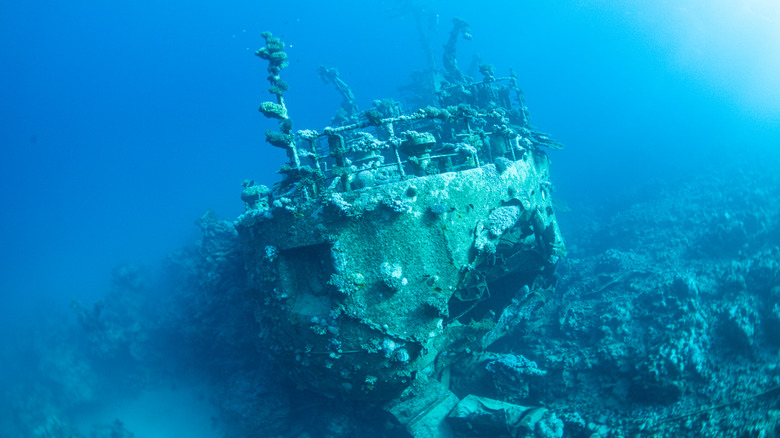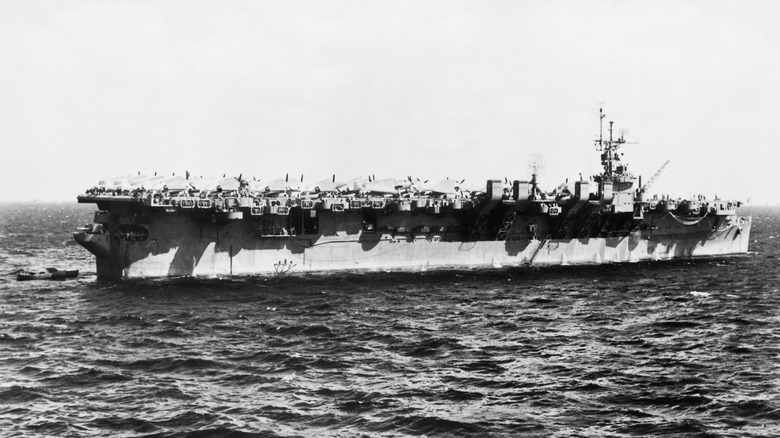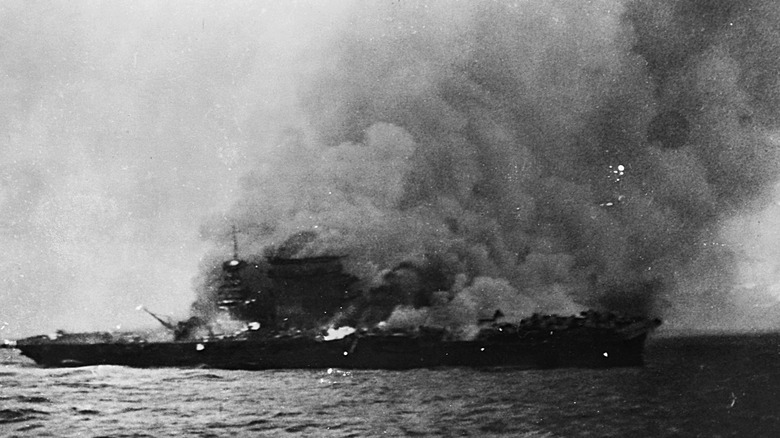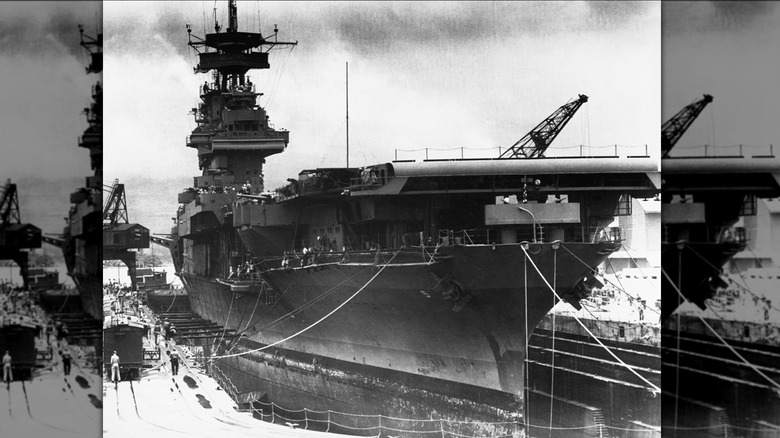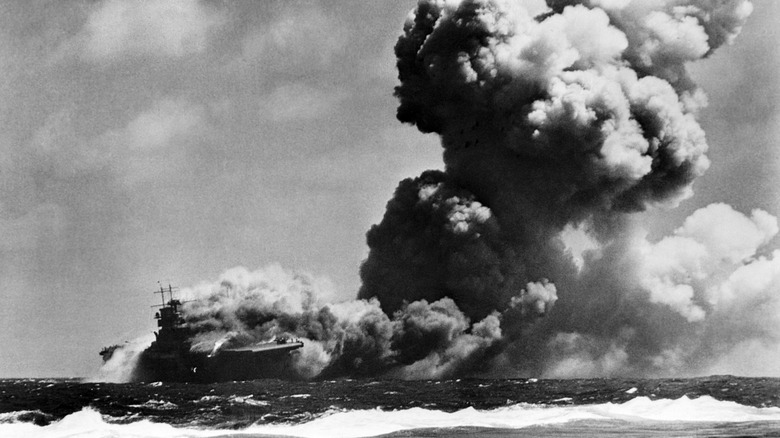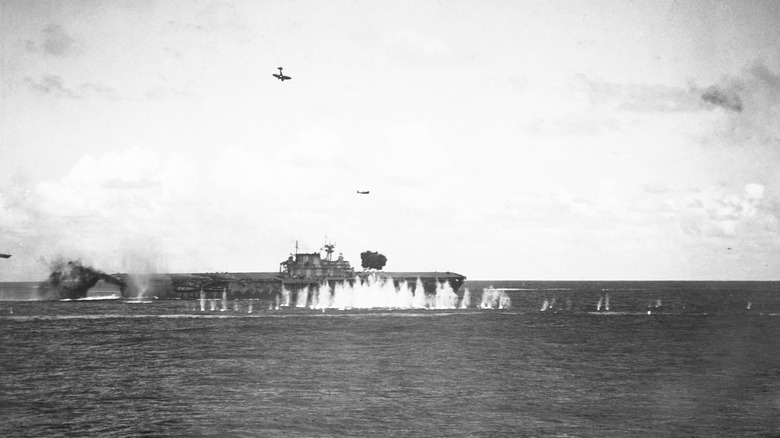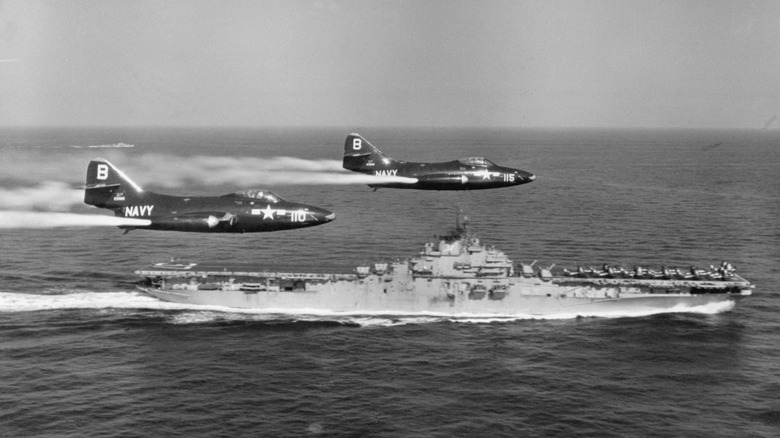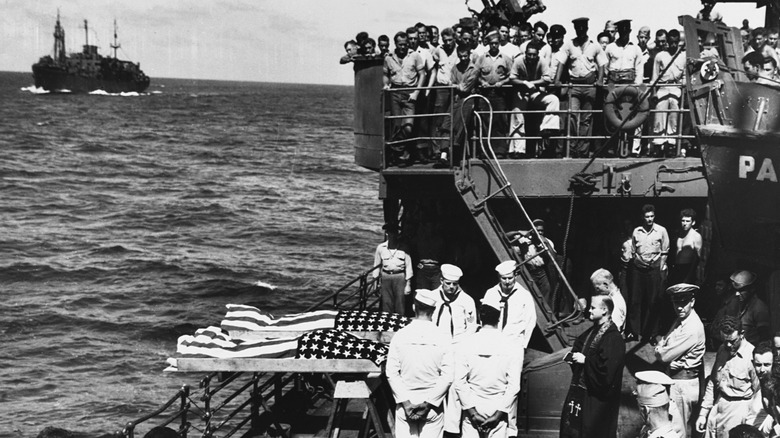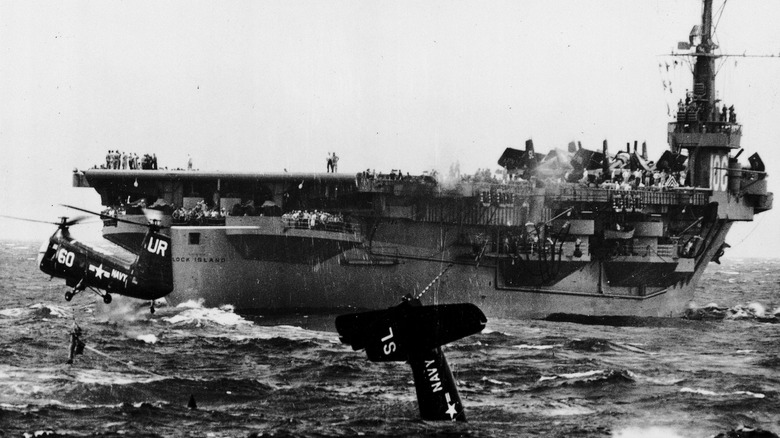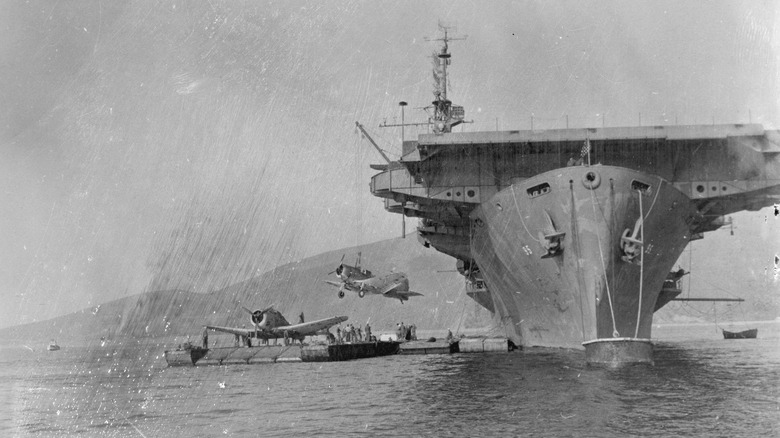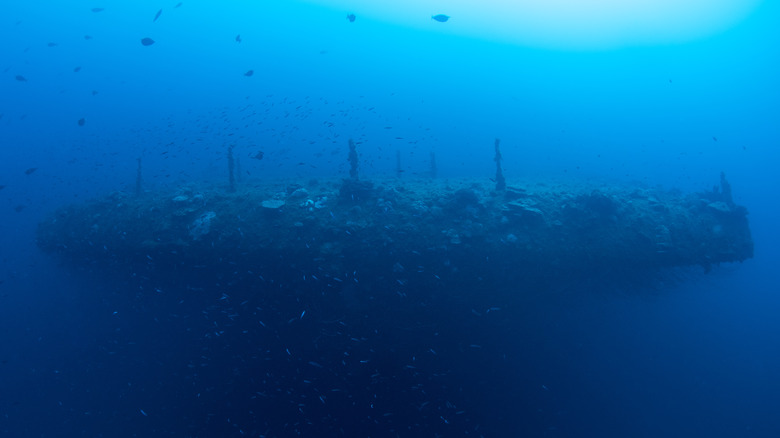10 Sunken US Navy Aircraft Carriers (And Their Current Location)
Aircraft carriers have played a pivotal role in naval warfare since their inception. They have augmented the United States' ability to project power globally. The first U.S. aircraft carrier, the USS Langley (CV-1), is a far cry from the Gerald R. Ford class, the latest and most advanced class of U.S. aircraft carriers today. They have always been a formidable foe, with extensive defensive and attacking capabilities. They rarely sink.
That being said, 16 U.S. aircraft carriers have met a watery grave. Only two nations have ever destroyed a U.S. aircraft carrier. Japan destroyed several during World War II, while Germany sank one. Outside of this conflict, no other nation has ever sunk one, apart from the U.S. itself. Usually, an aircraft carrier is decommissioned and dismantled at the end of service. However, the U.S. has sunk several of its own aircraft carriers for various reasons.
Join us as we discuss a handful of sunken U.S. Navy aircraft carriers and their current location. We have chosen 10 that reflect the different roles these ships played and the fates they ultimately succumbed to. Nearly all of the ships we cover were destroyed in World War II, but we also cover one that America purposely sank. Our list tells the story of the Pacific Theater of War. It tells a story of global power projection. It also shows that no ship is unsinkable, and even such impressive feats of engineering can still meet a tragic fate.
USS Langley (CV-1)
The USS Langley (CV-1) has the notable distinction of being the United States' very first aircraft carrier. Originally commissioned as a collier named USS Jupiter (AC-3) in 1913, she was converted into an aircraft carrier in 1920. This consisted of adding a flight deck so airplanes could take off and land. It was a revolutionary move. On March 20, 1922, she entered service as a pioneer, heralding a new age of naval warfare.
Given the novel nature of the ship, no one was sure what was needed for a successful aircraft carrier. There was no precedent so the USS Langley was essentially an experiment. The USS Langley was instrumental in establishing norms and operational procedures that were adopted by future generations of aircraft carriers.
She had never engaged in direct combat, and in 1937, she was converted into a Seaplane Tender. On February 27, 1942, she was critically damaged by Japanese bombers while delivering aircraft to Allied forces in the Java Sea. Unfortunately, she was beyond salvaging so the crew decided to scuttle the ship. She was abandoned and then sunk by a torpedo from a U.S. destroyer to ensure she didn't fall into the hands of the Japanese.
The USS Langley lies somewhere on the bed of the Java Sea. Her exact resting place has never been found but she sank approximately 75 miles from the island of Java. Perhaps we will never find her exact resting place.
USS Lexington (CV-2)
The USS Lexington, known as Lady Lex, was commissioned on December 14, 1927. Originally conceived as a battlecruiser, plans had to change due to the 1922 Washington Naval Treaty. Instead, she was converted into the United State's second aircraft carrier and was ready to enter service by the end of the 1920s.
She was an impressive ship, carrying over 90 aircraft and traveling at over 30 knots. She displaced over 33,000 tons and was almost 900 feet long. Throughout the 1930s, she played a key role in developing and refining naval and aviation techniques. She took part in fleet exercises, wargames, and aircraft operations.
On December 7, 1941, the infamous day, Japan launched a surprise attack on Pearl Harbor. The U.S. duly declared war on the Japanese, and the USS Lexington, which luckily wasn't at Pearl Harbour, was called straight into action. She is best remembered for her role in the Battle of the Coral Sea, the first air and sea battle in history, fought in May 1942. This was the first naval engagement fought entirely with aircraft.
Though she helped to sink two Japanese aircraft carriers, On May 8, she was fatally damaged by Japanese aircraft. Efforts to save her were futile and she became the first U.S. aircraft carrier lost during World War II. The exact location of the wreck remained unknown for decades, until her discovery in 2018. She lies on the bed of the Coral Sea off the coast of Queensland, Australia.
USS Yorktown (CV-5)
Commissioned on September 30, 1937, the USS Yorktown (CV-5) was part of the Yorktown class of aircraft carrier, along with the USS Enterprise and USS Hornet. These significantly improved the earlier carriers, and they played a key role in World War II. They were formidable enemies and impressive ships. They could carry more aircraft, had improved range, could travel faster, and had better defenses.
The USS Yorktown played a key role in two pivotal naval battles in World War II. First, she was instrumental in halting the Japanese advance in the Battle of the Coral Sea in 1942. She was also critical in helping the U.S. win the Battle of Midway. The sinking of the Japanese carrier Sōryū, was made possible by the positioning and tactics of the USS Yorktown. Her indispensable role in both of these battles has guaranteed her legacy in the annals of the Second World War.
Ultimately, her fate was a tragic one. She almost sank in the Battle of the Coral Sea. On May 8th, she sustained significant damage, and it was only the exceptional work of her crew that kept her afloat. She returned to Pearl Harbor and was fully repaired before being launched back into action. During the Battle of Midway, however, she took a critical hit from the Japanese submarine I-168 on June 7, 1942.
The ship remained undiscovered until 1998 when Robert Ballard, the same man who found Titanic, found her final resting place. She lies at a depth of about 16,650 feet near Midway Atoll in the Pacific Ocean.
USS Wasp (CV-7)
The USS Wasp (CV-7) was commissioned on April 25, 1940. She was the only ship in her class and was designed to maximize aircraft capacity and military competence while still adhering to the Washington Naval Treaty. She was short-lived but led an active operational career, as she was ready just in time for World War II.
The USS Wasp displacedabout 14,500 tons and could carry up to 80 aircraft. Her steam turbines allowed her to achieve speeds of nearly 30 knots. For her two years in operation, she played a vital role in the U.S. carrier fleet. She began in the Atlantic, ferrying planes to Iceland. She was then reassigned to the Mediterranean, delivering aircraft to the British forces in Malta. This helped the island fend off attacks from Axis air raids. In 1942, she was transferred to the Pacific Theater, where the Americans were heavily focused on defeating the Japanese. Here, she took part in key operations, including the Guadalcanal campaign.
This was to be her final contribution. On September 15, 1942 while escorting a convoy to Guadalcanal, she was torpedoed by the Japanese submarine I-19. It caused catastrophic damage, and the crew was forced to abandon ship. U.S. forces scuttled the ship It was a significant victory for the Japanese navy, as the USS Wasp was an excellent carrier, extremely adept to the demands of World War II.
She remained undiscovered on the floor of the Coral Sea until 2019. An expedition led by Vulcan Inc. uncovered her final resting place. She lies on the seabed of the Coral Sea, close to the Solomon Islands, 4,200 meters below the surface.
USS Hornet (CV-8)
The USS Hornet (CV-8) was commissioned on October 20, 1941. Another member of the Yorktown class of aircraft carriers, she played a key role in boosting American morale early in the war. She was in service for almost exactly one year before she was sunk.
Given that she was a pre-World War II vessel, her size was limited by international naval treaties. Still, she was over 800 feet long and nearly 20,000 tons. She could reach speeds of over 30 knots and carry approximately 90 aircraft. Her most significant contribution came during Operation Doolittle, on April 18, 1942. She launched 16 B-25 bombers who carried out airstrikes on the Japanese mainland. Though the damage inflicted was negligible, it demonstrated the U.S. ability to project power across the Pacific and significantly boosted the morale of U.S. forces.
She continued to operate in the Pacific Theater including the Battle of Midway and the Guadalcanal campaign. On October 26, 1942, during the Battle of the Santa Cruz islands, she was critically damaged by Japanese dive bombers. Efforts to save her proved futile and the U.S. forces abandoned her. On October 27, Japanese destroyers inflicted the fatal blow as she sank beneath the waves.
Her exact location remained uncertain until 2019 when she was discovered by an expedition funded by the philanthropist Paul Allen. She lies close to the Santa Cruz islands in the Solomon Sea.
USS Princeton (CVL-23)
The USS Princeton, commissioned on February 25, 1943 was a light aircraft carrier that was deployed in the Pacific Theater during World War II. She was originally classified as a Cleveland class light cruiser but was later converted to allow her to enter service more quickly.
As a small carrier with a displacement of about 11,000 tons, she was 622 feet long and could carry around 45 aircraft. Her diminutive size meant she could be built and deployed more quickly than the larger carriers, making her a valuable asset. She was involved in several key battles in the Pacific, including the Mariana and Palau Islands campaigns.
Her short life came to an end on October 24, 1944, during the Battle of Leyte Gulf when she was hit by a Japanese bomb. This explosion acted as the spark for more explosions on the ship itself. The crew tried to save her but the damage was too extensive and she ultimately sank. Though she met her demise, the battle itself is seen as a major turning point in the war. The Japanese fleet essentially stopped being an effective fighting force. They had lost too many ships and couldn't replace them. The USS Princeton played a key role in this. The wreck of the USS Princeton lies somewhere in the Philippine Sea. Her exact location remains a mystery. Perhaps one day she will be found.
USS Liscome Bay (CVE-56)
The USS Liscome Bay (CVE-56), commissioned on August 7, 1943, was a Casablanca-class escort carrier that served in the Pacific theater in World War II. The Casablanca class was a product of the war, and they are the most numerous and smallest class of aircraft carriers ever built. Over 50 of them entered service, but none survived.
Liscome Bay was very small, with a displacement of only 7,800 tons and a length of just over 500 feet. She could carry up to 30 aircraft and travel up to 19 knots. She reflected the U.S. Navy's need to get ships into the water quickly and systematically. Her primary task was to provide air cover and support during the many amphibious operations the U.S. was undertaking in islands all over the Pacific.
In the end, the only mission she ever took part in was the Battle of Makin in November 1943. The U.S. was in the process of successfully capturing the Taraw and Makin islands. On November 24, 1943, Liscome Bay was preparing to join in on the action. As the crew were preparing the aircraft for flight, she was torpedoed by the Japanese submarine I-175. The torpedo struck the bomb magazine, causing an intense explosion that split the ship in two. She sank quickly and over 600 of her crew perished in the sinking. The wreck lies near the Gilbert Islands in the Pacific Ocean.
USS Block Island (CVE-21)
The USS Block Island (CVE-21), commissioned on March 8, 1943, was a Bogue-class escort carrier that served solely in the Atlantic. The Bogue-class escort carrier was also a mass-produced ship that reflected the demands of World War II. Of these ships, 45 were commissioned during the war, and they played a key role in the Atlantic theater, providing air support for convoys and anti-submarine warfare operations.
Her primary role was to protect Allied shipping from German U-boats, which were patrolling the Atlantic shipping routes. She was an apex predator, and her aircraft helped sink several submarines. Her operations helped ensure supply lines across the Atlantic were never broken.
On May 29, 1944, she was torpedoed by the German submarine U-549. The attack was catastrophic, and she began flooding uncontrollably. Gallant efforts were made to save her, but the decision came to abandon ship, and she sank beneath the waves of the Atlantic. Nearly the entire crew survived, thanks to the quick response to the attack.
The final resting place of the USS Block Island isn't certain but it is somewhere near the Canary Islands. She was the only aircraft carrier that sank in the Atlantic theater. She was also the only aircraft carrier sunk by the Germans. In the end, it accomplished nothing for the German war effort as the U.S. had ramped up production of aircraft carriers to such a degree that they totally dominated the Atlantic theater by this stage of the war.
USS Bismarck Sea (CVE-95)
The USS Bismarck Sea (CVE-95), commissioned on May 20, 1944 was a Casablanca-class escort carrier. She, along with her 49 sister ships, were an integral factor in the U.S. victory over Japan. She epitomized the U.S. ability to outmanufacture and outmaneuver the Japanese as the war went on.
Reflecting ships in her class, the Bismarck Sea could only carry about 30 aircraft and displaced approximately 7,800 tons. She was built for efficiency and the U.S. could build a ship like her in about three months. Her most important contribution to the war effort was also her last. During the invasion of Iwo Jima, she provided critical air cover and support. She helped guarantee that the U.S. maintained air superiority and could carry out amphibious landings relatively unscathed.
Two days into the invasion of Iwo Jima, on February 21, 1945, she was struck by two kamikaze aircraft. The attacks proved fatal as devastating fires spread throughout the ship. She sank quickly, losing 318 members of her crew in the attack.
She was the last U.S. aircraft carrier lost during World War II. Between May 1942 and the invasion of Iwo Jima in 1945, the Japanese destroyed five U.S. aircraft carriers. The U.S. was able to produce ships at such a rate that ultimately, the impact on the war was negligible. The USS Bismarck Sea rests in the Philippines Sea, near Iwo Jima. No nation has ever destroyed a U.S. aircraft carrier since.
USS Saratoga (CV-3)
The USS Saratoga (CV-3) was a Lexington-class carrier that was commissioned on November 16, 1927. She was the nation's third-ever aircraft carrier and one of the largest. She was the sister of the USS Lexington (CV-2), and they were built to the same design. They ultimately had very different fates.
She had a relatively long career and was involved in many different aspects of the U.S. Navy throughout the 1930s and 1940s. She was integral in the development of naval tactics as the U.S. Navy used her in many fleet exercises and training missions. During World War II, she was involved in many of the campaigns in the Pacific Theater, including the Battle of the Eastern Solomons in 1942, where she was damaged and had to be repaired. She also played a key role in the invasion of Iwo Jima in 1945. Here, she suffered serious damage, but didn't flounder.
She managed to survive the entirety of World War II, but her fate was decided when she was chosen for Operation Crossroads. She was selected as a target ship for atomic bomb testing at Bikini Atoll. On July 25, 1946 an atomic weapon detonated under the water. It caused catastrophic damage to the ship and she began to flood. After several hours she sank to the bottom of Bikini Atoll. Her location is extremely accessible and the site has become a popular place for divers interested in the wreck.
